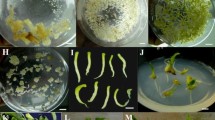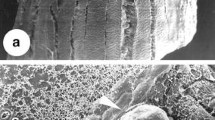Abstract
Eryngium foetidum L. is an important plant cultivated as a leafy vegetable and for its essential oil, which are of high economic value in international trade market. Plants were regenerated through somatic embryogenesis from mature leaf explants of field grown plants. Leaf explants produced dark brown, compact callus on Linsmaier and Skoog (LS) medium with the combination of 1.0 mg l-1 2,4-dichlorophenoxy acetic acid (2,4-D) and 1.0 mg l-1 benzylaminopurine (BAP). Somatic embryos were induced from embryo-forming callus cultures on Murashige and Skoog (MS) medium supplemented with 0.1 mg l-1 2,4-D, 2.0 mg l-1 BAP and 1.0 mg l-1 gibberellic acid (GA3). Subsequently, conversion of these somatic embryos into plantlets occurred on MS medium supplemented with 1.0 mg l-1 GA3 and/or 0.1 mg l-1 BAP. The regenerated shoots were rooted and elongated on MS medium supplemented with 0.1 mg l-1 IAA and 1.0 mg l-1 GA3. These plantlets were hardened and transferred to the soil.
Similar content being viewed by others
References
Arockiasamy S & Ignacimuthu S (1998) Plant regeneration from mature leaves and roots of Eryngium foetidum L., a food flavouring agent. Curr. Sci. 75: 664-666
Chang WC & Hsing Y (1980) Plant regeneration through somatic embryogenesis in root derived callus of ginseng (Panax ginseng CA Meyer). Theor. AppI. Genet. 57: 133-135
Culafic L, Budirmir S, Vujicic R & Neskovic M (1987) Induction of somatic embryogenesis and embryo development in Rumex acetosella L. Plant Cell Tiss. Org. Cult. 11: 133-139
Davey MR & Power JB (1988) Aspects of protoplast culture and plant regeneration. Plant Cell Tiss. Cult. 12: 115-125
Hunault G & Du manoir (1992) Micropropagation of fennel (Foeniculum vulgare Miller). In: Bajaj YPS (Ed) Biotechnology in Agriculture and Forestry. Vol. 19, High-Tech and Micropropagation III (pp 199-217). Springer Verlag, Heidelberg
Hunault G, Desmarest P & Du manoir J (1989) Foeniculum vulgare Miller, Cell culture regeneration and the production of anethole. In: Bajaj YPS (ed) Biotechnology in Agriculture and Forestry, Vol. 7. Medicinal and Aromatic Plants (pp 185-212). Springer Verlag, Berlin, Heidelberg.
Johansen DA (1940) Plant microtechnique. McGraw Hill, New York
Lakshmi Sita G, Rhagava Ram NV & Vaidyanathan CS (1979) Differentiation of embryoids and plantlets from shoot callus of sandal wood. Plant Sci. Lett. 15: 265-270
Linsmaier EM & Skoog F (1965) Organic growth factor requirements of tobacco tissue cultures. Physiol. Plant. 18: 100-127
Mohammed M (1992) Post-harvest constraints and solutions involved in export marketing of selected speciality and exotic vegetables from the West Indies, Acta Horticulturae. 318: 355-362
Murashige T & Skoog F (1962) A revised medium for rapid growth and bioassays with tobacco tissue cultures. Physiol. Plant. 15: 473-497
Pino JA, Rosado A & Fuentes V (1997) Composition of the leaf and root oils of Eryngium foetidum L. J. Ess. Oil Res. 9: 467-468
Reinert J (1973) Aspects of organisation organogenesis and embryogenesis. In: Street HE (ed) Plant Tissue and Cell Culture (pp 338-355). Black well Scientific Publications, London
Saenz MT, Fernandez MA & Garcia MD (1997) Anti inflammatory and analgesic properties from leaves of Eryngium foetidum L. Apiaceae. Phytotherapy Res 11: 380-383
Saikia A & Shadeque A (1996) Propagation methods of some underexploited leaf vegetables of north east India. J. Hill Res. 9: 59-61
Sankat CK & Maharaj V (1996) Shelf life of the green herb 'shado beni' (Eryngium foetidum L.) stored under refrigerator conditions. Post Harvest Biol. Technol. 7: 109-118
Wong KC, Feng MC, Sam TW & Tan GL (1994) Composition of the leaf oil of Eryngium foetidum L. from Cuba. J. Ess.Oil Res. 6: 369-374
Xiao XG & Branchard M (1983) Embryogenesis and plant regeneration of spinach (Spinach oleracea L.) from hypocotyl segments. Plant Cell Rep 13: 69-71
Author information
Authors and Affiliations
Rights and permissions
About this article
Cite this article
Ignacimuthu, S., Arockiasamy, S., Antonysamy, M. et al. Plant regeneration through somatic embryogenesis from mature leaf explants of Eryngium foetidum, a condiment. Plant Cell, Tissue and Organ Culture 56, 131–137 (1999). https://doi.org/10.1023/A:1006228310864
Issue Date:
DOI: https://doi.org/10.1023/A:1006228310864




